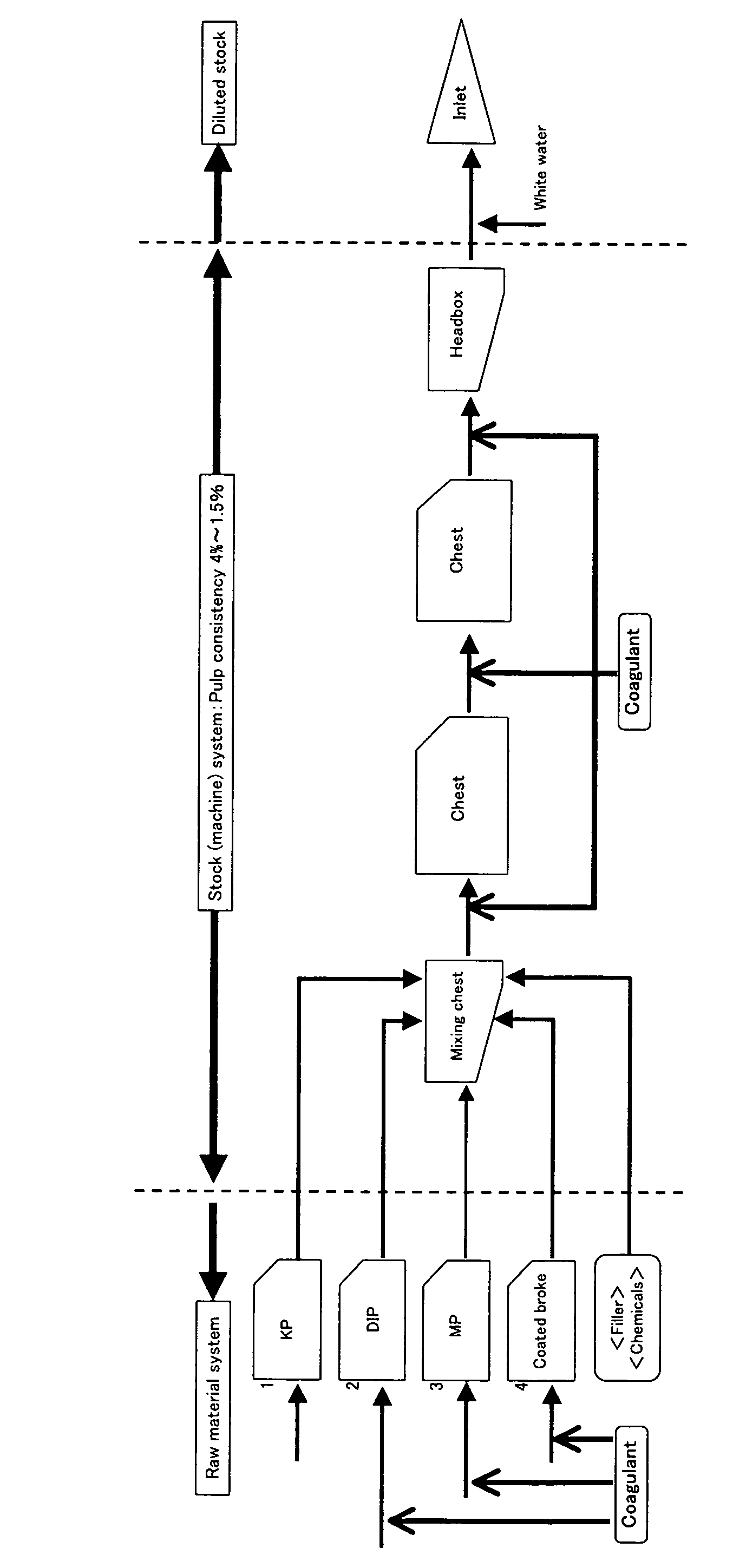Methods for producing coating base papers and coated papers
a coating base paper and coating technology, applied in papermaking, non-fibrous pulp addition, retention agent addition, etc., can solve the problems of gap former type paper machine, low internal bond strength, and decrease in fines in the middle layer of paper, so as to achieve good formation and internal bond strength, high retention, and good print quality
- Summary
- Abstract
- Description
- Claims
- Application Information
AI Technical Summary
Benefits of technology
Problems solved by technology
Method used
Image
Examples
examples
[0114]The following examples further illustrate the present invention without, however, limiting the invention thereto as a matter of course. Unless otherwise specified, parts and % in the examples mean parts by weight and % by weight, respectively.
[0115]Determination methods used in the following experimental examples are shown below.
[0116]
[0117](1) Determination Method of Retentions
[0118]The stock inlet raw material and white water having fallen through the wire (hereinafter referred to as wire white water) were tested for solids content and ash content. Ash content was determined by incinerating the solids in the stock inlet raw material and wire white water at 525° C.
[0119]Stock retention and ash retention were determined by equations (1) and (2) below, respectively.
Stock retention=100×(A−B) / A equation (1)
[0120]A: Solids content (g / l) in the stock inlet raw material
[0121]B: Solids content (g / l) in the wire white water
Ash retention=100×(C−D) / C equation (2)
[0122]C: Ash content (...
experiment 1
[0129](1) Paper machine: a roll and blade gap former type paper machine, or a blade gap former type paper machine.
[0130](2) Pulp raw material formulation: 50% hardwood kraft pulp (freeness CSF=350 ml), 20% softwood kraft pulp (freeness CSF=600 ml), 30% deinked pulp (freeness CSF=240 ml).
[0131](3) Filler content in paper (ash content in paper): Scalenohedral precipitated calcium carbonate (mean particle size 2.5 μm) was used in an amount appropriately adjusted to a desired ash content in paper.
example 1
[0132]To a stock consisting of a mixture of pulp and filler were added 0.2% of an amphoteric polyacrylamide (DS4340 from Seiko PMC Corporation) as an internal synthetic dry paper strength agent based on the solids weight of the stock and 300 ppm of a cationic polyacrylamide-based retention aid having a weight-average molecular weight of 20,000,000 determined by intrinsic viscosity measurement (REALIZER R300 from SOMAR Corporation, cationic charge density 1.96 meq / g) based on the solids weight of the stock, and the mixture was treated in a roll and blade gap former type paper machine having a forming roll diameter of 1600 mm and including two tandem show presses at a machine speed of 1,600 m / min to form a base paper for coated printing paper having a basis weight of 44 g / m2 and an ash content in the paper of 15%.
PUM
| Property | Measurement | Unit |
|---|---|---|
| speed | aaaaa | aaaaa |
| speed | aaaaa | aaaaa |
| speed | aaaaa | aaaaa |
Abstract
Description
Claims
Application Information
 Login to View More
Login to View More - R&D
- Intellectual Property
- Life Sciences
- Materials
- Tech Scout
- Unparalleled Data Quality
- Higher Quality Content
- 60% Fewer Hallucinations
Browse by: Latest US Patents, China's latest patents, Technical Efficacy Thesaurus, Application Domain, Technology Topic, Popular Technical Reports.
© 2025 PatSnap. All rights reserved.Legal|Privacy policy|Modern Slavery Act Transparency Statement|Sitemap|About US| Contact US: help@patsnap.com

